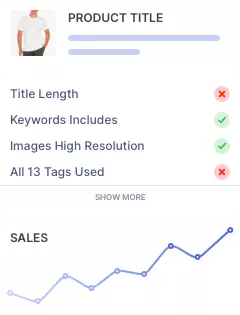What is Competitor Analysis in E-Commerce? How to Conduct?
Every business owner who wishes to thrive and remain relevant shouldn’t enter the market blindly. You should find out what others are doing, particularly those dominant in the market. That’s where competitor analysis comes in. As an e-commerce brand, you should conduct competitor analysis regularly and implement the results to grow your business.

But what exactly is a competitor analysis? Better still, how can an e-commerce conduct a competitor analysis?
This guide covers the meaning of competitor analysis and provides a comprehensive guide to conducting competitor analysis in e-commerce. You also learn why this is important and how it benefits your business. As a bonus, we cover helpful Roketfy tools that play a significant role in e-commerce growth.
Keep reading to find out.
What is Competitor Analysis?
Competitor analysis refers to examining your competitors to determine what they are doing to succeed in the market. You identify their strengths and incorporate these strategies to outdo them.
You also identify their weaknesses and optimize them. For a competitor analysis to be successful, it should be thorough and cover every aspect to get all relevant details.
How to Conduct Competitor Analysis in E-Commerce?
To conduct competitor analysis in e-commerce, start by identifying your competitors, then proceed to analyze their websites and online store in general. Check their social media presence to find where they receive high engagement, then analyze all their operations in general. Finally, conduct a SWOT analysis to identify Strengths, Weaknesses, Opportunities, and Threats.
Step 1: Know Your Competitors
The most important step is to identify your competitors. Your competition is either direct or indirect. Direct competitors provide the same products or services to yours. For example, if you sell baby clothes online, your direct competitor is another e-commerce store that sells baby clothes in the same location.
Indirect competitors serve the same needs but offer different services or products. For example, Coca-cola and coffee. Though both are beverages, one is a soft drink while the other is a hot beverage.
Though you should identify both direct and indirect competitors in the market, direct competitors are more important, because they are substitute and serve the same purpose. To identify indirect competitors:
- Ask your customers about the businesses they were considering before settling on yours. Roketfy AI Reviews helps extract insights from your customers’ reviews. Some customers may compare your services to your competitors in their reviews. With Roketfy AI Reviews, you can identify search insights and use these competitors in your analysis.
- Check social media pages like Facebook and online communities like Reddit or Quora. You can learn your competitors by investigating customer conversations.
- Conduct market research to know who offers the same services or products to your market.
- Google e-commerce stores offering the same services in your demography.
Don’t dismiss indirect competitors. Sometimes the market shifts, and it’s wise to watch them to stay on top of the game.
Step 2: Analyze Your Competitor’s Online Store
Now that you know the competitors, the next step is to analyze their online stores. Check how the site appeals to users, the design, and overall user experience.
Check out the theme used and the general appearance of the site. Specifically, check their product pages and see how they structure and describe products. The About and Home page are also important. They describe the business, mission, vision and story behind. As such, you learn where the business is going. Note what they are doing best and their weaknesses.
Another important aspect is their Search Engine Optimization (SEO). Do they have a blog? If yes, what keywords are they targeting? In addition, how is their content structured to rank higher?
All this are important aspects that will help outrank them. Once you’ve identified the keywords, you can use tools like Roketfy AI Writer to create quality SEO friendly product descriptions and attract more buyers.
By analyzing your competitors online store, you also learn their products or services and how they price them. Pay attention to discounts and other offers and use this to adjust your pricing strategy.
Step 3: Check Your Competitors’ Social Media Presence
In this digital era, social media plays a huge role in marketing especially for e-commerce stores. Online stores use Facebook, Instagram, Twitter and Youtube to market their businesses, reach new customers and increase traffic to their site.
It is therefore important to check your competitor’s social media pages and analyze metrics such as likes and comments. This helps identify areas your customers are often active. You can also go deeper and identify when they are mostly active on social media. This way, you know when to post to reach more audience.
In addition, check how your competitors are marketing their products or services in these pages. Are they using influencers regularly? Such insights will help restructure your marketing strategy.
Step 4: Understand Your Competitors’ Functioning and Operations
Pay attention to how your competitors operate. How do they deliver to customers? What are their marketing strategies? Brand positioning?
This research presents new data that can be used for your benefit. For example, learning their method of delivery to customers helps you compare with your delivery methods and learn why customers prefer one to the other.
Understanding your competitors operations gives access to the right information and tools used to succeed in the market.
Step 5: Conduct a SWOT Analysis
SWOT stands for Strengths, Weaknesses, Opportunities, and Threats.
- Strengths are areas your competitors thrive
- Weaknesses are aspects they are struggling in
- Opportunities are gaps your competitors create, giving you an added advantage
- Threats are aspects your competitors threaten your e-commerce store
A SWOT analysis will help you identify areas to improve and opportunities to capitalize on.
The Importance of Competitor Analysis for E-commerce
Conducting a competitor analysis helps an e-commerce business understand the market and identify new gaps to tap into so it beats competitors. There are always new trends in the marketplace, and through competitor analysis, an e-commerce store can adapt.
It helps understand the market
Through competitor analysis, e-commerce gets a better understanding of the market. While identifying your competitors’ strengths and weaknesses, you learn what customers like or dislike about their products or services. This gives you an idea into what your target customers want and expect from businesses.
You also learn new market segments. For example, you might identify a new location where competitors have not dominated.
It helps beat competitors at the game
With an understanding of the market, you can use this knowledge to outdo your competitors. You customize your products or services to satisfy consumers since you know exactly what they are looking for in your products or services. You also expand your services to new market segments reaching more customers.
It helps with adaptability
The online market is always evolving. Continuous competitor analysis helps e-commerce businesses stay updated with new market trends and adapt accordingly.
It helps enhance your business strategy
E-commerce can use the knowledge acquired from competitor analysis to reach its business goals. They can make new plans or re-adjust to achieve their goals with the new information.
It increases revenue
Knowledge acquired from competitor analysis may lead to more revenue. For example, if you discover a new market segment during the analysis, you can dominate this market, making more sales.
Final Thoughts
Competitor analysis plays a huge role in business growth. New and existing e-commerce stores should conduct competitor analysis regularly to understand the market, keep up with new trends, and beat competitors.
And since e-commerce stores operate online, you can get most of your competitors’ information online. You can also interact directly with competitors, as you can always present as a customer.
Now that you know how to conduct a competitor analysis for your e-commerce, do it regularly and implement the results to boost your sales and increase revenue.
Remember, Roketfy offers numerous tools to help grow your business. To get started, sign up and start using these incredible tools immediately!




